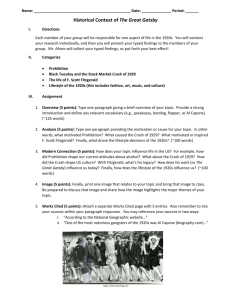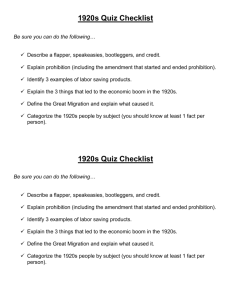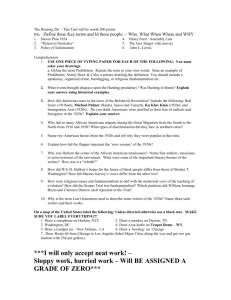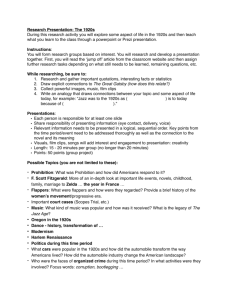Final gatsby pre-reading research
advertisement
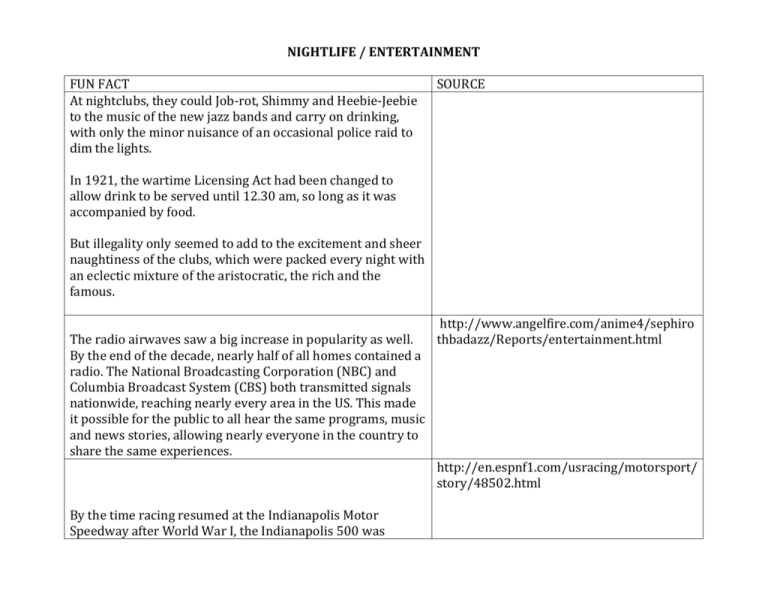
NIGHTLIFE / ENTERTAINMENT FUN FACT At nightclubs, they could Job-rot, Shimmy and Heebie-Jeebie to the music of the new jazz bands and carry on drinking, with only the minor nuisance of an occasional police raid to dim the lights. SOURCE In 1921, the wartime Licensing Act had been changed to allow drink to be served until 12.30 am, so long as it was accompanied by food. But illegality only seemed to add to the excitement and sheer naughtiness of the clubs, which were packed every night with an eclectic mixture of the aristocratic, the rich and the famous. The radio airwaves saw a big increase in popularity as well. By the end of the decade, nearly half of all homes contained a radio. The National Broadcasting Corporation (NBC) and Columbia Broadcast System (CBS) both transmitted signals nationwide, reaching nearly every area in the US. This made it possible for the public to all hear the same programs, music and news stories, allowing nearly everyone in the country to share the same experiences. http://www.angelfire.com/anime4/sephiro thbadazz/Reports/entertainment.html http://en.espnf1.com/usracing/motorsport/ story/48502.html By the time racing resumed at the Indianapolis Motor Speedway after World War I, the Indianapolis 500 was already a renowned sporting event, attracting an international entry of drivers and cars and a crowd of more than 100,000. http://en.wikipedia.org/wiki/Speakeasy During the Prohibition, nightclubs became speakeasies that sold illicit alcohol. They were called speakeasies because they were not to be spoken of. Before Prohibition, saloons were exclusively male institutions, so drinking was generally a sexually segregated activity. As speakeasies exploded during Prohibition, they no longer saw any point in discriminating. The 1920s also gave rise to the “party,” where men and women gathered to drink cocktails, flirt, dance to music, and gossip about their absent friends. People feared that Prohibition-era gangsters would sell fake alcohol or industrial alcohol (used in aftershave, explosives, etc.), so during this period they began to order classier, more expensive drinks. http://nymag.com/nightlife/features/65625 / http://nymag.com/nightlife/features/65625 / http://nymag.com/nightlife/features/65625 / FUN FACT Guys had short sleek hair back then TRENDS / FASHION SOURCE http://www.fashion-era.com/flapper_fashion_1920s.htm The hem length got shorter http://thegreatgatsbyreadingmap.blogspot.com/p/1920sfashion.html The waist band got looser http://thegreatgatsbyreadingmap.blogspot.com/p/1920sfashion.html Fashion was referred to as the flapper style http://womensfashion.lovetoknow.com/1920%27s_Fashion http://en.wikipedia.org/wiki/1920s_in_Western_fashion Skirts were shorter with pleats, gathers, or slits Women adopted a long straight silhouette in their skirts and dresses http://en.wikipedia.org/wiki/1920s_in_Western_fashion One of the first women cut her hair and rejected the corset, which was Coco Chanel Younger men started wearing wide length trousers and their clothing started getting baggy, also no man in any class was out in public without a wearing a hat http://en.wikipedia.org/wiki/1920s_in_Western_fashion http://mensfashion.lovetoknow.com/Men's_Fashion_in_the_1920s LITERATURE/FITZGERALD FUN FACT SOURCE Copies of Great Gatsby were still in the warehouse when he Great Gatsby Book died, contrary to the myth that they were all sold. Fitzgerald was Second l. but never saw foreign combat, which is one of his greatest regrets. The narrator of the book saw combat and changed his life due to it. http://www.shmoop.com/f-scottfitzgerald/timeline.html In 1925 Adolf Hitler produced his first autobiography titled http://www.1920-30.com/literature/ Mein Kampf or My Struggle http://www.shmoop.com/f-scott- The Fitzgerald’s rented a house in Long Island. The couple's interactions with Long Island society provide the setting and mood for the novel germinating in Fitzgerald's head. fitzgerald/timeline.html Fitzgerald wife was a flapper dancer http://library.thinkquest.org/C005846/catego ries/artliter/artslit.htm http://library.thinkquest.org/C005846/catego ries/artliter/artslit.htm http://blog.enslow.com/2010/09/interestingfacts-about-f-scott.html His writings included 150 stories and 5 monologues. His full name was Francis Scott Key Fitzgerald and he was named after the man who composed "The Star Spangled Banner. https://www.boundless.com/history/fromFitzgerald’s The Great Gatsby is often described as the new-era-to-great-depression-1920perfect example of the Jazz Age in American Literature. It’s 1933/culture-change/literature/ quite interesting because when one thinks of Jazz, we think of African American musicians, and so far, the story has only mentioned Caucasians. So how is it the perfect example when those who were a vital part of Jazz haven’t been mentioned? ROLE OF WOMEN / WOMEN’S RIGHTS Fun Fact The Matrimonial Causes Act was passed so that in the event of a divorce both spouses are considered equal Source http://library.thinkquest.org/C005 846/categories/worldnews/world Even though women gained more job opportunities, they were still seen as less than men. Often times, men would not trust his business affairs in the hands of a woman. n.htm http://historyclass.tripod.com/id1 2.html Because women could perform such jobs as well as men but be paid at more than 40% less than men’s wage, more and more women are afford jobs in business companies http://historyclass.tripod.com/id1 2.html Before the 1920s, women were not allowed to enter bars but in the 1920s, drinking was regarded as a more sophisticated practice so more and more women are seen in bars http://library.thinkquest.org/C005 846/categories/worldnews/world n.htm 1920s saw the first generation of women college graduates http://library.thinkquest.org/C005 846/categories/worldnews/world n.htm http://ic.galegroup.com/ic/uhic/R eferenceDetailsPage/ReferenceDet ailsWindow?failOverType=&query= &prodId=UHIC&windowstate=nor mal&contentModules=&mode=vie w&displayGroupName=Reference& limiter=&currPage=&disableHighlig hting=true&displayGroups=&sortB y=&source=&search_within_results =&zid=&action=e&catId=&activityT ype=&scanId=&documentId=GALE %7CCX3409000869 To an older generation of Americans the flapper symbolized a "revolution in manners and morals. On November 14, 1917, 30 women in Occuquan Workhouse were beaten, threatened, and mistreated in what would be coined “Night of http://historywired.si.edu/detail.cf m?ID=492 Terror”. President Wilson also originally denied any resistance to the feeding and that force-feeding or any other forceful methods wasn’t being used. As a result of this, all suffrage prisoners were released. The National Women’s Party was the first cause to picket in from of the White House. http://historywired.si.edu/detail.cf m?ID=492 POLITICS / ECONOMY / CRIME FUN FACT SOURCE The purple gang was a gang formed by Jewish immigrants Sandlin Silverman, K. (2000). The Purple that ran Detroit during the prohibition era. They were mainly Gang (Book Review). Library Journal, involved in supplying liquor to “blind pigs” (establishments 125(14), 229. that sold liquor illegally), hijacking liquor shipments and murder. During their reign, they were largely untouchable, until internal conflicts destroyed the group from the inside out. Al Capone is short for Alfonso Capone and he was born in 1899 and died in 1947. Al Capone’s nickname was scarface because he had a knife cut on his cheek. He was known for being the leader of the Chicago Outfit starting in 1925, which later became known as the Capones. Throughout the years, Capone used violence to eliminate his enemies, most notably the Valentines Day Massacre of 1929, which cemented his control of the Chicago underworld. CAPONE, Al. (n.d). http://web.ebscohost.com/ehost/detail? vid=4&sid=f4b2767a-94fb-4962-a5c8b3846c45cf55%40sessionmgr12&hid= 125&bdata=JnNpdGU9ZWhvc3QtbGl 2ZQ%3d%3d#db=funk&AN=CA037900 There was a huge gap between the rich and the poor and too Arnesen, E. (2010). STOCK MARKET CRASH. few rich people. The spending of the rich kept the economy intact throughout the 1920s, however on October 29th, the stock market crashed and investor sold their devaluing stocks in a hurry. People began to withdraw their money from the banks leading to banks to shutdown. Cobblestone, 31(5), 32. Prohibition was the federal ban on the manufacturing, transportation, and sale of alcohol in the 1920s. Prohibition came out of the temperance movement of the early 1900s, and by the end of World War I, prohibition became the law. During this time, gangs took advantage for the demand of alcohol and were able to make huge profits by selling it to costumers. Since large scale smuggling was so impossible to stop, and the large increase of crime, the prohibition law was soon repealed by the twenty-first amendment. Prohibition. (2013). Columbia Electronic Encyclopedia, 6th Edition, 1. The automotive industry began in the 1920s. Henry Ford debuted his Model A in the early 1920s and later his Model T in 1927. The mass production of these vehicles were possible because of the assembly line. Chevy kept pressure on Ford and outsold Ford in 1927. This decade introduced new highspeed efficient engines. The United States signed its own separate treaty with Germany to end World War I, but tensions between the two countries did no cease. This was partially due to the harshness of the treaty, which forced Germany to give up many of its acquisitions and aid in the restoration of "Automobiles." American Decades. Ed. Judith S. Baughman, et al. Vol. 3: 1920-1929. Detroit: Gale, 2001. U.S. History In Context. Web. 14 Apr. 2013. "The Progressive Era (1890–1930)." Gale Encyclopedia of U.S. History: Government and Politics. Vol. 2. Detroit: Gale, 2008. U.S. History In Context. Web. 14 Apr. 2013. governments it took over. Germany was not pleased with this, and indeed many historians consider this treaty ‘overly aggressive.’ This was one of the many factors that eventually led to World War II. Warren Harding and Teapot Dome Scandal: The Harding administration is best known for its in-depth corruption. Between 1923 and 1927, numerous members of Harding’s appointment were charged with various degrees of corruption, from stealing to graft to illegal business measures. The most nefarious of these scandals, known as the Teapot Dome Scandal, involved the president himself. In 1921, the secretary of the Navy, Edwin Denby, managed to get Harding to transfer control of a set of navy oil reserves from the navy to the Department of the Interior. The next year, the secretary of the interior, Albert B. Fall, ‘leased the land to friends in the oil industry without competitive bidding,’ which resulted in an alleged $400,000 gain for him. Denby ended up resigning and being sent to prison. Though there was no evidence that Harding knew much about the corruption in his administration (in fact, ‘most of the corruption was revealed after his death in August 1923), his lack of effort to deal with the rumors of corruption that started not long after he took office led many people to “put the blame” on him. John Dillinger was one of the most iconic bank robbers during the prohibition and great depression eras. He "The Warren G. Harding Administration." Presidential Administration Profiles for Students. Ed. Kelle S. Sisung and Gerda-Ann Raffaelle. Detroit: Gale Group, 2002. U.S. History In Context. Web. 14 Apr. 2013. Dillinger, John. (2013). In Encyclopædia Britannica. Retrieved from http://www.school.ebonline.com/eb/article- performed numerous high profile bank robberies, engaged in 9030455 gunfights with local police and the FBI and escaped from jail numerous times, earning him the repertoire of being a daring, and sharply dressed gunman. After escaping jail for the second time using only a fake pistol coated in bootblack, he was set up by his mistress and was shot and killed outside the biograph theater in Chicago. QUICK REFERENCE: http://webtech.kennesaw.edu/jcheek3/roaring_twenties.htm


